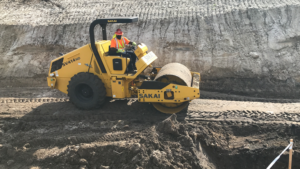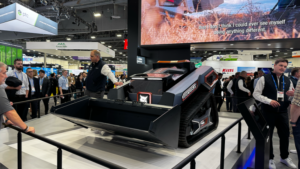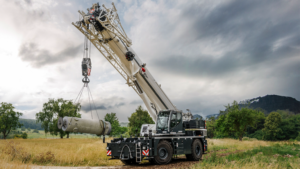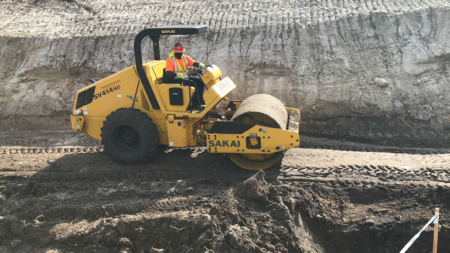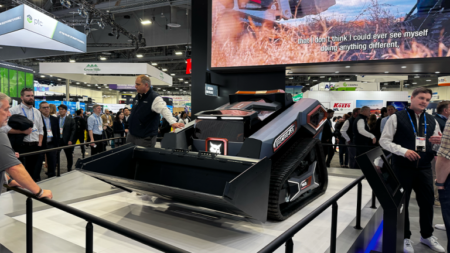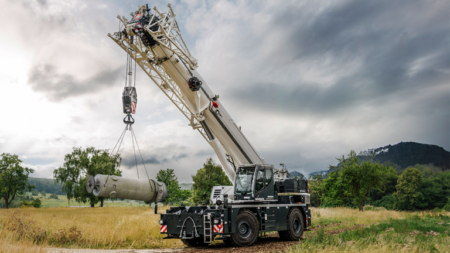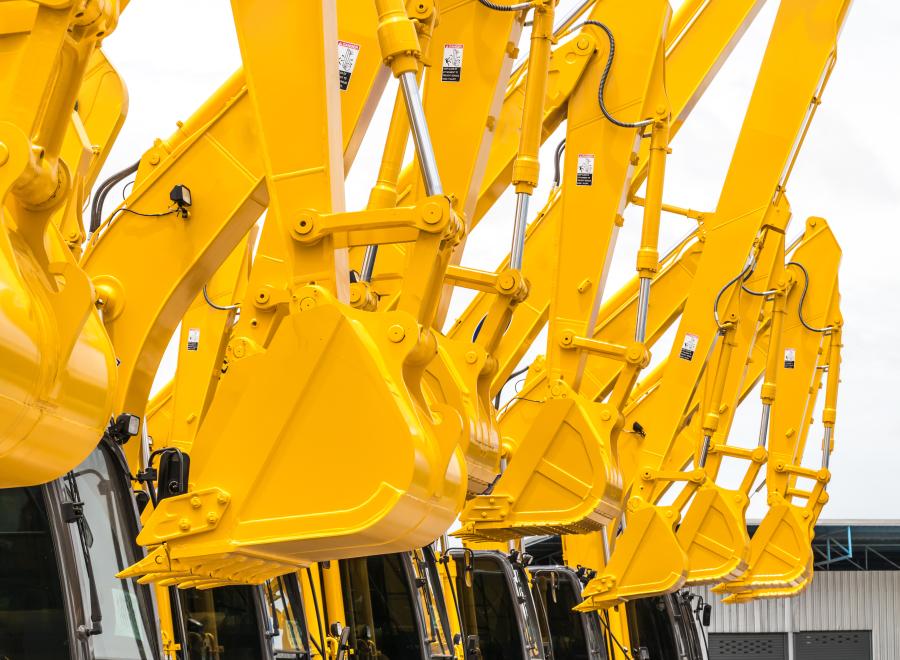
Adobe stock photo
AI is transforming the way fleet management teams communicate not only with each other but with the rigs at work on a job site.
The business of fleet management is always improving as better, more efficient ways to maintain equipment and prevent downtime circulate among users.
Research has found that equipment managers see the benefits of artificial intelligence as a tool to mitigate operational disruptions caused by escalating costs, safety regulations and sustainability and the demand for digital transformation.
This year Info-Tech Research Group published the results of research into factors affecting the fleet management industry.
In its report, “Practical Use Cases for AI in Fleet Management,” the company outlines five factors IT leaders must consider in harnessing AI’s benefits.
At its most basic AI, or machine learning, monitors large volumes of data that a telematics system can churn out.
As Teletrac/Navman explains, AI technology designed for fleet management clearly and concisely produces, analyzes and reports on that data.
“AI spots patterns and behaviors and can make recommendations based on the data,” said the company in a website article.
These tools develop expertise and offer data beyond alarms and status alerts, said Teletrac. AI offers a glimpse into the future of a machine or an entire fleet.
“It recognizes patterns that are hidden in the data and helps you answer the questions that you don’t know to ask,” the company said.
This is considered by the company to be “the biggest difference between AI and business intelligence.”
Where business intelligence requires the user know what questions to ask, AI uses data to identify factors most influencing outcomes. After identifying influencers, AI then provides recommended adjustments so the user can chart a course of action toward better fleet management.
Potential to Streamline Fleet Management
“The role of AI is to simplify data management and help fleet managers identify problem areas before they become an issue,” said Teletrac.
The technology then helps create real-time coaching and training programs a contractor can use right away.
According to Teletrac, AI factors in prediction with cause and effect and anticipation to streamline fleet management.
The company explains three scenarios AI has the capability to solve based on the data available are prediction, cause and effect and anticipation:
1. This seems familiar (prediction): We have seen “X” scenario before and “Y” was the result. In other similar cases, these situations tended to emerge.
2. I’ve noticed when this then and that (cause and effect):
3. Based on historical data, this is likely to occur (anticipation): For example, AI has noticed that reducing harsh driving generally increases vehicle lifespans and reduces fuel consumption.
“AI relies on data, and lots of it, to learn about operations and provide insights and predictions,” said Teletrac. “Fleet management systems capture an ever-increasing volume of data from a wide range of data points, which can be pulled into an AI processor.”
Data includes but is not limited to engine diagnostics ODB2 and J1939, CAN bus, runtime, maintenance, fuel usage idle times and location and driver hours.
Other data AI is capable of capturing pertains to dangerous and distracted driving, fatigue data and vehicle/asset utilization data.
Taking Asset Management By Storm
The construction industry has been lit by AI and according to Fleetio there’s no shortage of fleet management product offerings on the market right now.
They’re all designed to help fleets improve safety, productivity and decision making. Some systems are designed to work through smart devices.
Last year, data analytics software provider Foresight Intelligence integrated AI features into its Fleet Intelligence solution, controlled by voice.
Speaking in English or Spanish, mobile devices can be used via voice to request assistance with real-time information about the equipment.

Adobe stock photo
On the job site, dozers, excavators and trucks can be tracked for location, usage, maintenance and inspection details, based on the user’s role on the project.
Contractors, manufacturers, dealers and rental houses can better manage their assets, utilization and project outcomes deploying the right resources at the right time.
“Fleet Intelligence provides triggers and signals that allow teams to proactively manage their equipment, in the language of their choice,” said the company. “These new AI-powered features will have an incredibly positive impact on machine availability and project profitability.”
The AI-powered voice control features are designed to deploy and use easily with no training required or technology expertise needed.
Designed to be as simple as pushing a button and asking for information, the new features allow for quick adoption by crew members. As a result, the company said, the system promotes safety, ease of use in the field and efficiency.
“Fleet Intelligence helps our customers manage more equipment with fewer people,” said Dale Hanna, CEO. “Construction managers, fleet supervisors, technicians and operators will be able to access relevant fleet and equipment data in their preferred language.”
Purpose-built for the construction industry, the system provides “unparalleled” insights into every aspect of the mixed fleet environment.
“We’ve had telematics, sensors in equipment, computer managed componentry and other technological advancements,” said Ron Slee of Learning Without Scars.
This system “provides triggers and signals that will have a positive impact on machine availability and project profitability,” said the construction equipment trainer.
An AI-powered tire scanning program from Anyline gives smart devices the ability to read, interpret and process visual information.
With AI and computer vision in the company’s mobile tire tread scanner the user points a smart device at a tire and the app creates a digital model of it. The device reflects the tread depth of the scanned tire to provide accurate and consistent data, an improvement over the tradition of measuring with a quarter.
“All tire data collected via the app is automatically recorded and can be easily shared within an organization,” said Fleetio.
Users can link tire data to specific VINs or license plates to get greater visibility of tire health in relation to specific vehicles.
“By making it faster and easier to monitor tire health,” the app helps fleets replace or retread tires at optimal times, said Fleetio. “As a result, fleets benefit from reduced maintenance costs and higher vehicle uptime.”
Predictive maintenance analytics have become a key facet of a solid fleet management department.
With a goal of reducing unplanned downtime, Optimum Fleet Health’s system analyzes more than 8,000 performance indicators.
The AI-powered Optimum VRx predictive engine can anticipate system failures up to four weeks before they happen, asserts the developer.
“With the knowledge that a vehicle is likely to fail soon, fleets can head off unplanned downtime by scheduling preventive maintenance,” said Fleetio.
The technology also diagnoses the causes of issues and provides actionable resolution plans for fleet managers.
“By elevating the efficacy of preventive maintenance, fleets are able to minimize costly disruptions … and reduce replacement vehicle costs,” said Fleetio.
Predicting Fleet Management’s Future
In development by Bridgestone Mobility Solutions is a virtual fleet manager solution, which the company said will be available within two years.
It’s designed as “an extra pair of eyes for human fleet managers” who will feed the technology with data from various company operations systems.
“From there, the virtual fleet manager will interpret that data and provide recommendations and insights that humans might’ve overlooked,” said Fleetio. “Human fleet managers will be able to interact with the virtual fleet manager through questions and commands using everyday language a la ChatGPT.”
Raghunath Banerjee, Bridgestone’s vice president of data solutions, stressed that virtual fleet managers won’t be replacing humans anytime soon.
“They will get a virtual fleet manager who is really going to help them, train them, provide them with the right insight,” said Banerjee.
In its research, Info-Tech delved into the concept of how AI is capable of transforming fleet management.
The IT research firm offers practical cases to help fleet managers and IT leaders solve their asset management challenges.
“Data is being generated at an exponential rate due to technological advancements,” said Kevin Tucker, principal research director.
The rate makes it nearly impossible for humans to perceive and analyze all the data in a timely manner.

Adobe stock photo
“Fleet managers will increasingly need to use AI if they want to keep up with the … growth … for scalable transportation solutions and infrastructure.”
The complexity of implementation with legacy equipment and unsupported systems should not deter organizations from AI adoption, said Tucker.
“These systems are evolving, with the prospect of providing prescriptive instructions soon becoming a reality,” he said.
In its latest blueprint, Info-Tech highlights the importance for fleet managers to build collaborative partnerships with industry peers, tech companies and experts.
“With AI becoming a pivotal contributor to the fleet management solutions market, understanding its impactful delivery is imperative,” said the firm.
Here are five factors Info-Tech said both fleet managers and IT leaders must consider:
1. Be Intentional: Emphasize clarity about important AI adoption factors, such as policy, transparency, ethics and accuracy requirements.
2. Identify Embedded AI: Recognize and assess AI integration in products, even when it’s not immediately apparent, directly interactive or configurable.
3. Unmask Invisible AI: Diligently identify AI functionalities hidden within products.
4. Fix Hallucinations: Develop strategies to manage and mitigate the risks of AI-generated misinformation.
5. Enforce Responsible AI: Advocate for the development and deployment of trustworthy AI solutions.
Info-Tech maintains that AI in fleet management can also enable greater flexibility for remote and hybrid work models.
“This technological shift allows for remote monitoring, helping employees balance their personal and professional commitments,” said the company. CEG
Lucy Perry
Lucy Perry has 30 years of experience covering the U.S. construction industry. She has served as Editor of paving and lifting magazines, and has created content for many national and international construction trade publications. A native of Baton Rouge, Louisiana, she has a Journalism degree from Louisiana State University, and is an avid fan of all LSU sports. She resides in Kansas City, Missouri, with her husband, who has turned her into a major fan of the NFL Kansas City Chiefs. When she’s not chasing after Lucy, their dachshund, Lucy likes to create mixed-media art.
Read the full article here

